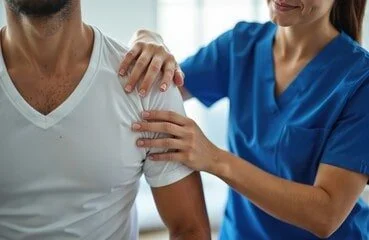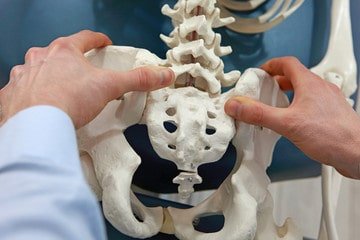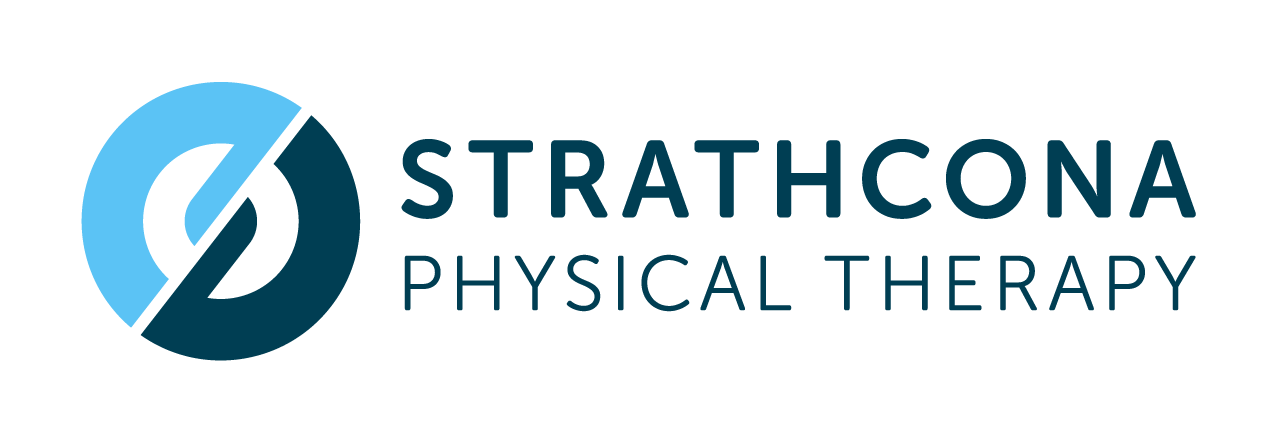
C7 Cervical Radiculopathy: Understanding Symptoms, Recovery, and Modern Treatment
C7 cervical radiculopathy is the most common neck-related nerve irritation, often causing triceps weakness, middle-finger tingling, and arm fatigue. This guide explains why it happens, how it affects the entire arm, and the modern rehab strategies that help the nerve heal and strength return.

The Future of Sports & Pain Rehab: Three Game-Changers—and How Our Clinics Are Leading the Shift
Sports and pain rehabilitation are evolving faster than ever. From wearable technology to neuro-first rehab and hybrid care, three major trends are redefining how athletes, MVA patients, and people with persistent pain recover. Here’s how the future of rehab is unfolding—and how our clinics are already ahead of the curve.

The Glute Max: Your Body’s Missing Powerhouse
The glute max is your body’s largest and most powerful muscle—yet for many people, it’s barely active. When it shuts down, your back, knees, and ankles work overtime. Learn why the glute max matters, how weak glutes affect your whole body, and the top exercises to wake this powerhouse back up.

Weighted Vest Walking: A Simple, Research-Backed Way to Build Strength, Bone Health, and Metabolic Fitness
Weighted-vest walking is a simple, low-impact way to turn regular walking into a strength-, bone-, and metabolism-boosting workout. With just 5–10% of your bodyweight, you can build leg strength, support bone density, improve posture, and enhance overall fitness—without the stress of running or high-impact exercise.

Walking Is Great — But It Doesn’t Work Everything
Walking is one of the best ways to stay active — but it doesn’t work every muscle. Learn which muscles walking strengthens, which ones it misses, and how to fill the gaps with simple strength and balance exercises to stay strong, stable, and injury-free.

You Can’t Skip Plyos: Why (Smart) Jump Training Belongs in Your Program
Plyometric training isn’t just for athletes—it’s for anyone who wants stronger joints, better balance, and real-world power. Smartly programmed jumps and hops strengthen tendons, improve landing mechanics, support bone health, and bridge the gap between strength and movement.

Hypermobility Playbook: Stabilize, Strengthen, Thrive
Hypermobility doesn’t have to mean fragility. With the right approach—focused on stability, proprioception, smart strength training, and lifestyle strategies—you can move with confidence and resilience. This playbook breaks down simple, evidence-based steps to help you thrive with hypermobility while protecting your joints and reducing flare-ups.

Jaw Deviation vs Jaw Deflection: What’s the Difference
When the jaw doesn’t open in a straight line, it may be a case of deviation or deflection. Deviation corrects mid-line before full opening, while deflection stays shifted to one side. This post explains the anatomical reasons, key muscle involvement, and evidence-based physiotherapy strategies—from posture training to jaw control exercises—to help restore smooth, pain-free function.

Botox for TMD, Jaw Pain, and Migraines: What You Need to Know
Botox is widely recognized for its cosmetic uses, but it also plays an important role in managing chronic migraine and select cases of jaw pain and TMD. This blog explores how Botox works, what the research shows, potential side effects, long-term concerns, and safe alternatives such as physiotherapy and relaxation techniques.

The Jaw–Neck Connection: Why Clenching Is More Than a Bad Habit
Jaw clenching isn’t just a dental habit—it’s a motor control issue tied to the neck. Overactivation of muscles like the sternocleidomastoid and upper trapezius during clenching can worsen pain, headaches, and posture. Learn how improving motor control in the jaw and neck reduces tension, restores balance, and helps break the cycle of chronic clenching.

Cervicogenic Headaches vs. Migraine: How to Tell the Difference—and What to Do
Headaches can feel similar, but not all headaches are the same. Cervicogenic headaches start in the neck and are often posture-related, while migraines are brain-based and bring throbbing pain, nausea, and light sensitivity. Knowing the difference is key, because treatment approaches differ—physiotherapy plays a primary role in cervicogenic headaches and a supportive role in migraine care. Learn how to spot the signs and find the right approach for lasting relief

The Body Remembers: How Trauma Lives in Our Muscles, Joints, and Nervous System
Trauma leaves a lasting imprint not only on the mind but on the body, showing up as chronic tension, joint pain, posture changes, and nervous system imbalance. This blog explores how trauma is stored in muscles and movement patterns, and how integrative therapies like physiotherapy, somatics, and breathwork can support deep healing.

The Pelvis: The Hidden Key to Shaping and Supporting a Scoliotic Spine
The pelvis is more than a bystander in scoliosis—it’s the foundation that shapes how the spine curves, twists, and compensates. Explore how pelvic alignment influences scoliosis progression and why combining pelvic corrections with Schroth therapy leads to better whole-body balance and function.

Functional Leg Length Discrepancy: A Whole-Body Physiotherapy Approach
Functional leg length discrepancy is a common but often overlooked issue that can affect posture, movement, and joint health. Unlike structural discrepancies, it stems from muscular or postural imbalances. Learn how physiotherapy can help you correct these issues and get back to moving with ease and confidence.

Can Ergonomics Alone Relieve Back, Neck & Joint Pain? What the Evidence Actually Says
Adjusting your workspace helps, but it's not the cure. Research shows that treating back, neck, and joint pain requires more than just good ergonomics. Find out why movement, strength, and body awareness matter more.

Do I Need an X-Ray After an Ankle Injury?
Twisted your ankle and wondering if you need an X-ray? Learn how to tell the difference between a simple sprain and something more serious. We break down the signs to watch for, when imaging is needed, and how to manage recovery.

The Lats You Forgot You Had: Why Your Latissimus Dorsi Is the Unsung Hero of Movement
Often overlooked but critically important, the latissimus dorsi muscle powers your pulling strength, supports your spine, and connects your upper body to your core. Learn why your lats are essential for posture, performance, and pain prevention—plus discover three progressive exercises to activate them effectively.

Movement in the Acute Phase: Why Rest Isn’t Always Best
Total rest after an injury isn’t always the best strategy. New research shows that gentle, controlled movement during the first 72 hours can promote circulation, maintain mobility, and support faster healing. Learn how physiotherapists safely guide recovery from day one.

The Lateral Pterygoid Muscle: A Key Player in Jaw Health and TMD
The lateral pterygoid muscle plays a crucial role in jaw movement, disc stability, and TMJ health. Dysfunction can contribute to pain, clicking, and jaw locking. Discover how a comprehensive physiotherapy approach can address these issues and restore jaw balance.

Understanding Your Obliques: Function, Importance & How to Train Them
Your obliques do far more than twist your torso—they support your spine, aid in breathing, and keep your core stable. This blog explores how obliques function, how they can get strained from everyday actions like coughing, and the best exercises to train them properly for strength and injury prevention.
